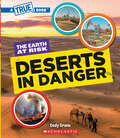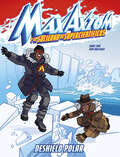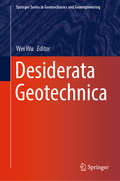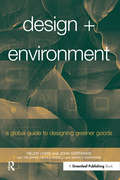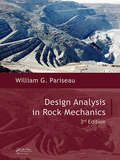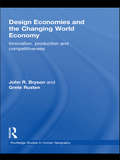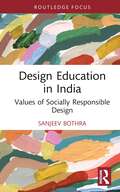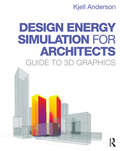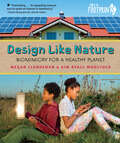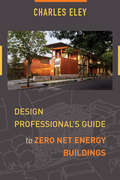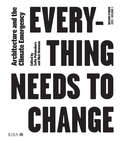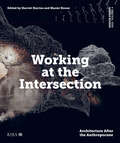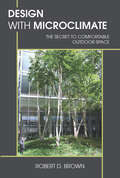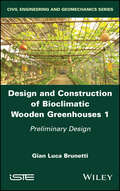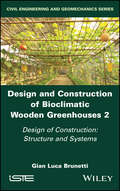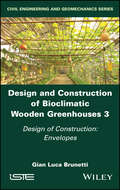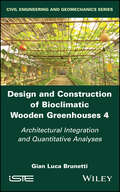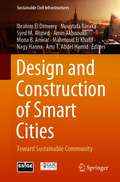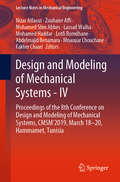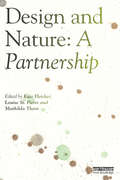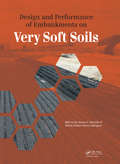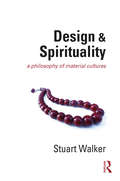- Table View
- List View
Deserts in Danger (A True Book (Relaunch))
by Cody CraneDiscover the rich biodiversity of Earth's biomes - and how they might be saved - with this STEAM-based subset of True Books.Did you know that the Sahara is the world's largest hot desert? Or that Antarctica is the world's largest cold desert? Get ready to investigate the driest places on the planet, hot and cold, as well as the plants and animals that have adapted to survive there. You'll also learn about the many threats facing this fascinating biome - and what each of us can do to help - all in the pages of Deserts in Danger.ABOUT THE SERIES:There are five major biomes on Earth: desert, forest, grassland, aquatic, and tundra. These rich, wild places are home to a wide variety of plants and animals - many of which are found nowhere else. Unfortunately, these ecosystems have been put at risk by human activities. This STEAM-based set of True Books introduces students to the incredible biodiversity of Earth's amazing biomes, as well as the threats they face in the era of climate change. Interesting information is presented in a fun, friendly way - and in the simplest terms possible - and will inspire kids to think about how they can help stop the destruction of Earth's wild spaces.
Deserts: A True Book
by Darlene R. StillePresents a general description of deserts and describes specific desert plants, animals, people, and activities.
Deshielo polar: una aventura de Max Axiom, súpercientífico (Max Axiom y la sociedad de supercientíficos)
by Carol Kim¡El hielo del Ártico está desapareciendo! Pero ¿por qué se derriten las cimas nevadas, los glaciares y los icebergs? En esta novela gráfica de no ficción, Max Axiom y la Sociedad de supercientíficos tienen la misión de averiguarlo. Utilizando sus superpoderes y su superinteligencia, el equipo desglosará cada pieza de este complejo problema medioambiental en una aventura emocionante e informativas para que los jóvenes lectores aprendan sobre las causas y los efectos del cambio climático y descubrir las medidas que todos podemos tomar para proteger las regiones polares y combatir el calentamiento global.
Desiderata Geotechnica (Springer Series in Geomechanics and Geoengineering)
by Wei WuThis book presents contributions to a workshop dedicated to Prof. Gerd Gudehus on the occasion of his 80th birthday and held in Vienna, Austria, on 14-16 August 2018. The articles gathered here, many of which were written by former students, friends and colleagues of Prof. Gudehus, cover diverse topics that reflect the breadth and depth of geomechanics research. Consequently, they offer a valuable source of ideas and inspiration on areas ranging from sophisticated constitutive models to advanced numerical methods, from particles to continua, and from fractals of geomaterials to the design of offshore wind turbine foundations.
Design + Environment: A Global Guide to Designing Greener Goods
by Helen Lewis Tim Grant John Gertsakis Nicola Morelli Andrew SweatmanThere is a huge scarcity of good, practical resources for designers and students interested in minimizing the environmental impacts of products. Design + Environment has been specifically written to address this paucity. The book first provides background information to help the reader understand how and why design for environment (DfE) has become so critical to design, with reference to some of the most influential writers, designers and companies in the field. Next, Design + Environment provides a step-by-step approach on how to approach DfE: to design a product that meets requirements for quality, cost, manufacturability and consumer appeal, while at the same time minimising environmental impacts. The first step in the process is to undertake an assessment of environmental impacts, using life-cycle assessment (LCA) or one of the many simpler tools available to help the designer. From then on, DfE becomes an integral part of the normal design process, including the development of concepts, design of prototypes, final design and development of marketing strategies. Environmental assessment tools and strategies to reduce environmental impacts, such as the selection of appropriate materials, are then discussed. Next, some of the links between environmental problems, such as global warming, ozone depletion, water and air pollution and the everyday products we consume are considered. In order to design products with minimal environmental impact, we need to have a basic understanding of these impacts and the interactions between them. The four subsequent chapters provide more detailed strategies and case studies for particular product groups: packaging, textiles, furniture, and electrical and electronic products. Guidelines are provided for each of the critical stages of a product's life, from the selection of raw materials through to strategies for recovery and recycling. Finally, Design + Environment takes a look at some of the emerging trends in DfE that are offering us the opportunity to make a more significant reduction in environmental impacts. Both the development of more sustainable materials and technologies and the growing interest in leasing rather than selling products are examined. Design + Environment is organized as a workbook rather than an academic text. It should be read once, and then used as a key reference source. This clear and informative book will prove to be invaluable to practising designers, to course directors and their students in need of a core teaching and reference text and to all those interested in learning about the tools and trends influencing green product design. The authors have all been involved in an innovative demonstration programme called "EcoReDesign", which was developed by the Centre for Design at RMIT University with funding from the Australian government. The Centre successfully collaborated with Australian companies to improve the environmental performance of their products by following DfE principles.
Design Analysis in Rock Mechanics
by William G. PariseauThis comprehensive introduction to rock mechanics treats the basics of rock mechanics in a clear and straightforward manner and discusses important design problems in terms of the mechanics of materials. This extended third edition includes an additional chapter on Foundations on Jointed Rock. Developed for a complete class in rock engineering, this volume uniquely combines the design of surface and underground rock excavations and addresses:• rock slope stability in surface excavations, from planar block and wedge slides to rotational and toppling failures • shaft and tunnel stability, ranging from naturally-supported openings to analysis and design of artificial support and reinforcement systems • entries and pillars in stratified ground • three-dimensional caverns, with emphasis on cable bolting and backfill • geometry and forces of chimney caving, combination support and trough subsidence • rock bursts and bumps in underground excavations, with focus on dynamic phenomena and on fast and sometimes catastrophic failures. The numerous exercises and examples familiarize the reader with solving basic practical problems in rock mechanics through various design analysis techniques and their applications. Supporting the main text, appendices provide supplementary information about rock, joint, and composite properties, rock mass classification schemes, useful formulas, and an extensive literature list. The large selection of problems at the end of each chapter can be used for home assignment. A solutions manual is available to course instructors. Explanatory and illustrative in character, this volume is suited for courses in rock mechanics, rock engineering and geological engineering design for undergraduate and first year graduate students in mining, civil engineering and applied earth sciences. Moreover, it will form a good introduction to the subject of rock mechanics for earth scientists and engineers from other disciplines.
Design Economies and the Changing World Economy: Innovation, Production and Competitiveness (Routledge Studies in Human Geography)
by Grete Rusten John R. BrysonDesign is central to every service or good produced, sold and consumed. Manufacturing and service companies located in high cost locations increasingly find it difficult to compete with producers located in countries such as India and China. Companies in high-cost locations either have to shift production abroad or create competitive advantage through design, innovation, brand and the geographic distribution of tasks rather than price. Design Economies and the Changing World Economy provides the first comprehensive account of the relationship between innovation, design, corporate competitiveness and place. Design economies are explored through an analysis of corporate strategies, the relationship between product and designer, copying and imitation including nefarious learning, design and competitiveness, and design-centred regional policies. The design process plays a critical role in corporate competitiveness as it functions at the intersection between production and consumption and the interface between consumer behaviour and the development and design of products. This book focuses on firms, individuals, as well as national policy, drawing attention to the development of corporate and nation based design strategies that are intended to enhance competitive advantage. Increasingly products are designed in one location and made in another. This separation of design from the place of production highlights the continued development of the international division of labour as tasks are distributed in different places, but blended together to produce design-intensive branded products. This book provides a distinctive analysis of the ways in which companies located in developed market economies compete on the basis of design, brand and the geographic distribution of tasks. The text contains case studies of major manufacturing and service companies and will be of valuable interest to students and researchers interested in Geography, Economics and Planning.
Design Education in India: Values of Socially Responsible Design (Routledge Research in Social Design)
by Sanjeev BothraThis book traces developments in design education in India and shows the continuing impact of the Bauhaus School of design education, which formed the basis of the National Institute of Design. It presents the findings of the author's research and experiential learning as a design educator over a 25-year period. This book argues that as the effects of climate change and the exploitation of natural and human resources become more pervasive, it has become increasingly important to ensure that the values of social responsibility are instilled into the design students who will become future practitioners. This book offers an alternative model of understanding regarding the ecosystem of design and sustainable design education. Going beyond description and analysis, it includes three case studies of adoptable design curricula created by the author, with student responses to the programmes to provide first-hand insights into their impact. Research findings are based on detailed interviews with contemporary faculty members, all experts in the various design disciplines, along with an in-depth survey of existing design programmes in India. Design Education in India encourages a paradigm shift in thinking about the environment, spaces and places. It offers a unique perspective on the status of design education in an important and fast-growing economy and will be a useful read for design educators and researchers in varied disciplines.
Design Energy Simulation for Architects: Guide to 3D Graphics
by Kjell AndersonLeading architectural firms are now using in-house design simulation to help make more sustainable design decisions. Taking advantage of these new tools requires understanding of what can be done with simulation, how to do it, and how to interpret the results. This software-agnostic book, which is intended for you to use as a professional architect, shows you how to reduce the energy use of all buildings using simulation for shading, daylighting, airflow, and energy modeling. Written by a practicing architect who specializes in design simulation, the book includes 30 case studies of net-zero buildings, as well as of projects with less lofty goals, to demonstrate how energy simulation has helped designers make early decisions. Within each case study, author Kjell Anderson mentions the software used, how the simulation was set up, and how the project team used the simulation to make design decisions. Chapters and case studies are written so that you learn general concepts without being tied to particular software. Each chapter builds on the theory from previous chapters, includes a summary of concept-level hand calculations (if applicable), and gives comprehensive explanations with graphic examples. Additional topics include simulation basics, comfort, climate analysis, a discussion on how simulation is integrated into some firms, and an overview of some popular design simulation software.
Design Like Nature: Biomimicry for a Healthy Planet (Orca Footprints #20)
by Megan Clendenan Kim Ryall Woolcock★“Fascinating…An appealing resource sure to spark an interest in biomimicry, from casual readers to budding scientists. Recommended for all libraries.”—School Library Journal, starred review Did you know that lamps can be powered by glowing bacteria instead of electricity? That gloves designed like gecko feet let people climb straight up glass walls? Or that kids are finding ways to make compostable plastic out of banana peels? Biomimicry, the scientific term for when we learn from and copy nature, is a revolutionary way to look to nature for answers to environmental problems such as climate change. In Design Like Nature young readers discover innovations and inventions inspired by the environment. Nature runs the entire planet with no waste and no pollution. Can humans learn to do this too? It's time to step outside and start designing like nature.
Design Professional's Guide to Zero Net Energy Buildings
by Charles EleyIn the United States, direct energy use in buildings accounts for 39% of carbon dioxide emissions per year--more than any other sector. Buildings contribute to a changing climate and warming of the earth in ways that will significantly affect future generations. Zero net energy (ZNE) buildings are a practical and cost-effective way to reduce our energy needs, employ clean solar and wind technologies, protect the environment, and improve our lives. Interest in ZNE buildings, which produce as much energy as they use over the course of a year, has been growing rapidly.In the Design Professional's Guide to Zero Net Energy Buildings, Charles Eley draws from over 40 years of his own experience, and interviews with other industry experts, to lay out the principles for achieving ZNE buildings and the issues surrounding their development. Eley emphasizes the importance of building energy use in achieving a sustainable future; describes how building energy use can be minimized through smart design and energy efficiency technologies; and presents practical information on how to incorporate renewable energy technologies to meet the lowered energy needs. The book identifies the building types and climates where meeting the goal will be a challenge and offers solutions for these special cases. It shows the reader, through examples and explanations, that these solutions are viable and cost-effective.ZNE buildings are practical and cost-effective ways to address climate change without compromising our quality of life. ZNE buildings are an energizing concept and one that is broadly accepted yet, there is little information on what is required to actually meet these goals. This book shows that the goal is feasible and can be practically achieved in most buildings, that our construction industry is up to the challenge, and that we already have the necessary technologies and knowledge.
Design Studio Vol. 1: Architecture and the Climate Emergency
by Sofie Pelsmakers; Nick NewmanWant to keep up with emerging design thinking and issues worldwide? Design Studio is a new thematic series that distils the most topical work and ideas from schools and practices globally. The first volume launches with a statement: Everything Needs to Change. Exploring architecture and the climate emergency, editors Sofie Pelsmakers (author of Environmental Design Sourcebook) and Nick Newman (climate activist and Director at Studio Bark), are channelling the message of Greta Thunberg to inspire, enthuse and inform the next generation of architects. Featuring articles, building profiles and case studies from a range of leading voices, it explores solutions to climatic, environmental and social challenges. It urges readers to radically rethink what it means to be an architect in an era of climate crisis, and what the role of the architect is or can be. Discover how using local materials, working with nature, radical design processes, transformative learning and activism can help us find hope in the burning world. Together, we can force change for a more sustainable and equitable tomorrow. This first volume is produced in four unique fluorescent colours – green, red, yellow and purple – to be your own poster for change.
Design Studio Vol. 4: Architecture After the Anthropocene
by Harriet Harriss Naomi HouseWithout environmental justice, there can be no social justice. This volume sets the table for inclusive architectural engagement during a time circumscribed by pandemic, climate change and inequality. An esteemed group of international voices amplify interactions involving sexism, racism, classism, homophobia, transphobia and environmental catastrophe, exploring how they inextricably linked. Without acknowledging the interconnectedness of these injustices, we will not find effective ways to halt the deepening crisis. Features: Marcos Cruz, Casper Laing Ebbensgaard, Antón García-Abril, Alexandra Daisy Ginsburg, Ariane Lourie Harrison, Kerry Holden, Walter Hood, Joyce Hwang, Kabage Karanja, V. Mitch McEwen, Débora Mesa, Timothy Morton, Stella Mutegi, Brenda Parker, Carolyn Steel, McKenzie Wark, Kathryn Yusoff and Joanna Zylinska.
Design With Microclimate: The Secret to Comfortable Outdoor Space
by Robert D. BrownRobert Brown helps us see that a "thermally comfortable microclimate" is the very foundation of well-designed and well-used outdoor places. Brown argues that as we try to minimize human-induced changes to the climate and reduce our dependence on fossil fuels-as some areas become warmer, some cooler, some wetter, and some drier, and all become more expensive to regulate-good microclimate design will become increasingly important. In the future, according to Brown, all designers will need to understand climatic issues and be able to respond to their challenges. Brown describes the effects that climate has on outdoor spaces-using vivid illustrations and examples-while providing practical tools that can be used in everyday design practice. The heart of the book is Brown's own design process, as he provides useful guidelines that lead designers clearly through the complexity of climate data, precedents, site assessment, microclimate modification, communication, design, and evaluation. Brown strikes an ideal balance of technical information, anecdotes, examples, and illustrations to keep the book engaging and accessible. His emphasis throughout is on creating microclimates that attend to the comfort, health, and well-being of people, animals, and plants. Design with Microclimate is a vital resource for students and practitioners in landscape architecture, architecture, planning, and urban design.
Design and Construction of Bioclimatic Wooden Greenhouses, Volume 1: Preliminary Design
by Gian Luca BrunettiDesign and Construction of Bioclimatic Wooden Greenhouses, Volume 1: Preliminary Design
Design and Construction of Bioclimatic Wooden Greenhouses, Volume 2: Design of Construction: Structure and Systems
by Gian Luca BrunettiDesign and Construction of Bioclimatic Wooden Greenhouses, Volume 2: Design of Construction: Structure and Systems
Design and Construction of Bioclimatic Wooden Greenhouses, Volume 3: Design of Construction: Envelopes
by Gian Luca BrunettiDesign and Construction of Bioclimatic Wooden Greenhouses, Volume 3: Design of Construction: Envelopes
Design and Construction of Bioclimatic Wooden Greenhouses, Volume 4: Architectural Integration and Quantitative Analyses
by Gian Luca BrunettiDesign and Construction of Bioclimatic Wooden Greenhouses, Volume 4: Architectural Integration and Quantitative Analyses
Design and Construction of High-Performance Homes: Building Envelopes, Renewable Energies and Integrated Practice
by Franca TrubianoBoth professionals and students are increasingly committed to achieving high-performance metrics in the design, construction and operation of residential buildings. This book responds to this demand by offering a comprehensive guide which features: architectural innovations in building skin technologies which make lighter more transparent buildings high performing; energy-free architectural design principles and advances in building-integrated photovoltaics; essential engineering principles, controls and approaches to simulation for achieving net zero; the advantages of integrated design in residential construction and the challenges and opportunities it engenders; detailed case studies of innovative homes which have incorporated low-energy design solutions, new materials, alternative building assemblies, digital fabrication, integrated engineering systems and operational controls. Divided into four parts, the book discusses the requisite AEC (Architecture, Engineering and Construction) knowledge needed when building a high-performance home. It also communicates this information across four case studies, which provide the reader with a thorough overview of all aspects to be considered in the design and construction of sustainable homes. With contributions from experts in the field, the book provides a well-rounded and multi-faceted approach. This book is essential reading for students and professionals in design, architecture, engineering (civil, mechanical and electrical), construction and energy management.
Design and Construction of Smart Cities: Toward Sustainable Community (Sustainable Civil Infrastructures)
by Nagy Hanna Syed M. Ahmed Ibrahim El Dimeery Moustafa Baraka Amin Akhnoukh Mona B. Anwar Mahmoud El Khafif Amr T. Abdel HamidThis book focuses on how to maintain environmental sustainability as one of its main principles, and it addresses how smart cities serve to diminish wastes and maintain natural resources by having clean green energy that is operated by new smart technology designs. Living in a smart city is not something of the future anymore, it is here, and it is being implemented all over the world. A smart city uses different types of electronic Internet of things (IoT) sensors to collect data and then use these data to manage assets and resources efficiently. The smart city concept integrates information and communication technology (ICT), and various physical devices connected to the IoT network to optimize the efficiency of city operations and services and achieve sustainable solutions to allow us to grow with proper management of our resources.Smart sustainable structures and infrastructures face the need of urban areas due to the growth of populations while in the same time save our environment. To achieve this, we need to revisit the conventional methods in design and construction and the conventional materials which are used now to optimize the design and provide smart solutions. In the past few years, the consumption of resources has been massive, and the waste produced from that consumption has been inconceivable. This is causing environmental degradation, which produces many environmental challenges, such as global climate change, excessive fossil fuel dependency and the growing demand for energy.As well as, discussing the challenges facing the civil engineering design and construction of smart cities components and presenting concepts and insight from experts and researchers from different civil engineering disciplines., this book explains how to construct buildings and special structures and how to manage and monitor energy.
Design and Modeling of Mechanical Systems - IV: Proceedings of the 8th Conference on Design and Modeling of Mechanical Systems, CMSM'2019, March 18–20, Hammamet, Tunisia (Lecture Notes in Mechanical Engineering)
by Mohamed Slim Abbes Fakher Chaari Mohamed Haddar Lotfi Romdhane Abdelmajid Benamara Mnaouar Chouchane Nizar Aifaoui Zouhaier Affi Lassad WalhaThis book offers a collection of original peer-reviewed contributions presented at the 8th International Congress on Design and Modeling of Mechanical Systems (CMSM’2019), held in Hammamet, Tunisia, from the 18th to the 20th of March 2019. It reports on research, innovative industrial applications and case studies concerning mechanical systems and related to modeling and analysis of materials and structures, multiphysics methods, nonlinear dynamics, fluid structure interaction and vibroacoustics, design and manufacturing engineering. Continuing on the tradition of the previous editions, these proceedings offers a broad overview of the state-of-the art in the field and a useful resource for academic and industry specialists active in the field of design and modeling of mechanical systems. CMSM’2019 was jointly organized by two leading Tunisian research laboratories: the Mechanical Engineering Laboratory of the National Engineering School of Monastir, University of Monastir and the Mechanical, Modeling and Manufacturing Laboratory of the National Engineering School of Sfax, University of Sfax.
Design and Nature: A Partnership
by Louise St. Pierre Kate Fletcher Mathilda ThamOrganised as a dialogue between nature and design, this book explores design ideas, opportunities, visions and practices through relating and uncovering experience of the natural world. Presented as an edited collection of 25 wide-ranging short chapters, the book explores the possibility of new relations between design and nature, beyond human mastery and understandings of nature as resource and by calling into question the longstanding role for design as agent of capitalism. The book puts forward ways in which design can form partnerships with living species and examines designers’ capacities for direct experience, awe, integrated relationships and new ways of knowing. It covers: • New design ethics of care • Indigenous perspectives • Prototyping with nature • Methods for new design and nature relations • A history of design and nature • Animist beliefs • De-centering human-centered design • Understanding nature has power and agency Design and Nature: A Partnership is a rich resource for designers who wish to learn to engage with sustainability from the ground up.
Design and Performance of Embankments on Very Soft Soils
by Marcio de Almeida Maria Esther MarquesEmbankment construction projects on very soft soil often give rise to serious problems. This volume on geotechnics and soft soil engineering therefore treats all phases of the design and construction process exhaustively, from the first investigation step to the monitoring of constructed work. The book presents the development concepts necessary fo
Design and Spirituality: A Philosophy of Material Cultures
by Stuart WalkerDesign and Spirituality examines the philosophical context of our current situation and its implications for design. It explores how modernity and our constricted notions of progress have contributed to today’s crisis of values, and argues for a re-establishment and re-affirmation of self-transcending priorities, together with an ethos of moderation and sufficiency. A wide range of topics are covered, including material culture and spiritual teachings; sustainability and the spiritual perspective; traditional and indigenous knowledge; technology and spirituality; notions of meaningful design; and how particular material things can have deeper, symbolic significance. There are also reflections on areas such as the language of design; busyness and its relationship to wisdom; design and social disparity; and traditional sacred practices. While not avoiding issues that are controversial, and sometimes hard-hitting, Design and Spirituality gets to the heart of the key issues affecting us today and presents them in a highly readable and accessible format. The author is a leading thinker in the field and he presents his arguments in a manner that invites the reader to reflect and think about where we are going, why we are going there and what really matters.

